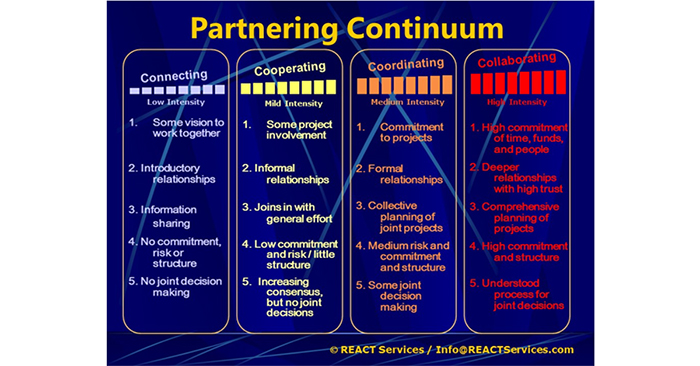Getting Past The Myths of Partnering


Just a few key things can make the difference between a distinctive, excellent organization and an average, ordinary one. These might be specific core values or a particular focus. But in 21st century ministry, it has to include the commitment and ability to partner well with others. Not surprisingly, partnership and collaboration are now major buzz words in the mission enterprise.
Organizations and businesses are using collaboration tools to solve internal challenges of redundancy and external problems of risk and resource scarcity. Recent polls and trends show that inner organizational collaboration tops the list of organizational priorities. Everyone is seeking to decrease costs and increase income. In addition, external partnering with other agencies can help elicit innovation and achieve even greater outcomes.
Why is partnering even more important in missions today? “For us, the main reason is that the fresh challenges we are facing – whether developing organizational strategy or responding to the accelerated change in our world – are more complex than they have ever been,” one senior missions CEO told me. “They seem to require a variety of new skill sets, perspectives, and approaches and need a lot of pieces to come together smoothly for meaningful success.”
Most leaders apparently want to be involved in partnership (or at least they say they do). The frustration many feel is that they just do not know how to move it forward. Your organization may be considering a new partnership or seeking to expand and deepen an existing partnership. In either case, your next steps derive from your operating assumptions.
So, before you jump off the partnering cliff (or even if you already have), keep in mind these four myths of partnering in order to make sure you don’t end up in dangerous waters.

Myth #1: Collaboration and Partnering
is New
Collaboration has existed since early man learned to hunt in groups. Partnering is not new yet a lot of hype suggests it is just now being introduced (especially internally with web-based tools). The reality is that employees have collaborated daily at the water cooler, at lunch, in the office, and by email. It just wasn’t named.
Though internal collaboration is not new, what is new are the means and tools that employees can use to collaborate with one another. Now, an employee can easily pull together a private group or online community to work together on a project, as opposed to sending emails back and forth. That same approach, of course, is working externally, too, as web-based document sharing has assisted in joint planning, the execution of events, and follow up strategies.
In field-based efforts, American leaders are beginning to mature in partnering as they increasingly learn to listen. Instead of merely viewing partnering as “here’s our project, come partner with us to achieve it,” they learn what collectively can be done to address situations that individual organizations cannot solve. The additional humility required for shared leadership, reduced control, and openness to discovering past and current mistakes is challenging. As one of my close non-western colleagues told me, there is a reason that even in a partnership like NATO, Americans refuse to let any other nation lead their troops. Are we open to participation without having direct leadership?
Myth #2: Everyone Knows What Partnering Means
One of the big challenges in 21st Century partnering is that we tend to use the term to mean a variety of different things. Partnering and collaboration needs to mean more than merely finding indigenous and local leaders (partners) to help expand your program. It is also more than identifying and growing your list of financial donors (partners). It is exploring and undertaking with like-minded groups what you can do together that you cannot do alone. Partnering can be represented by a continuum (see graphic) that includes everything from simply connecting to intense project cooperation. For example, if some groups find it difficult to collaborate on church planting, they can work together on less involved projects. Understanding where you are on the continuum can widely expand the possibilities for partnership – a key component in seeing real results.
Myth #3: Discover the Right Model and It Will Work
There is no magic formula or one particular model that works for partnering. No turn by turn GPS to look at for instructions. Every partnership and every collaborative effort is different because the people and the context are different. Performance and results are more directly related to long-term values and strategies like taking substantial time to build relationships and earn trust. Western leaders tend to think trust comes naturally, when in reality, there are few short cuts, particularly when working in multi-cultural settings. Trust allows us to learn the sophistication needed to embrace inevitable conflicts, and to appropriately deal with holding partners accountable to their commitments. In addition, partnering always requires ownership and designated leadership from each organization. Indeed, in multi-organizational efforts it usually takes an appointed catalyst who can follow up on next steps and keep things moving in the right direction.
Myth #4: Partnering is the Strategic Driver
Long ago, Phill Butler, founder of Interdev and later visionSynergy, would coach leaders saying “partnership for partnership sake just doesn’t work.” The whole point of collaboration is not collaboration itself, but solving larger problems by bringing to bear multiple resources, improving efficiency, and promoting increased ministry innovation. A useful partnership is results-focused. It is driven by a common vision for a preferable future. Among other things, that means understanding when it makes sense to partner (and when it does not), what the specific outcomes will be, what the added value will be to each partner, and what metrics need to be in place to measure success.
Partnering in 21st century organizational life is an essential component in moving from ordinary to excellent. However, we must not get stuck in the myths. We must be realistic about what partnering is, when it is necessary, and what is required to make it succeed. This means we must take the time and make the effort to explore the essentials of partnering, providing our people with the training and the space to work on it. In addition, we must work through the hard parts of listening in order to build stronger relationships and earn trust with potential partners; agree and commit to common strategic objectives; and follow through on the commitments made. It is a not an easy journey, but the results are worth it!









comments